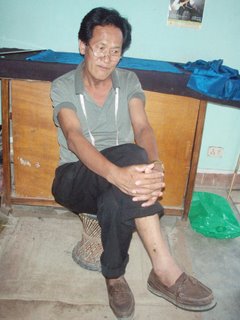
Dorje Tsering the tibetan tailor, my homestay father in 2003-04 in Boudha, Kathmandu, Nepal, who remains one of my best friends in the eastside neighborhood. I have dinner with him and his wife and daughter at least once a week, and often come by his modest shop to drink tea and chat. We usually talk about politics or local news. He is not a particularly educated man, and his serious thoughtful demeanor in this photo belies his goofy nature.

Ram and Santoshi Ballav in their dvd shop in Boudha, Kathmandu. I have been staying with them on and off this summer and last summer, as they manage the flats above their shop. It is a good deal for me since I can pay by the day for a room that shares a kitchen and bathroom with other students and travelers, so it has the feel of an apartment but the convenience of a guest house. I also have a near unlimited access to their dvd's, so i've watched some good ones lately, namely "spring, summer, fall, winter, and spring," "everything is illuminated," and "travellers and magicians," which is Dzongtsar Khyentse Rinpoche's new Bhutanese film.
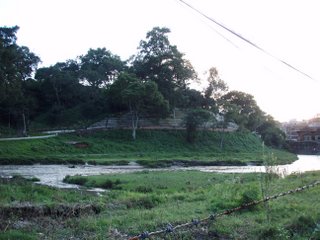
Looking southwest at sunset across the sacred Bagmati River in east Kathmandu towards the Kirateshwar hill, which is topped by an old sangeetashram, a community space for devotional musicians. Every purnima (full moon evening) they hold a free public concert showcasing local Hindustani classical artists, I've probably attended six in the last three years. It is my favorite venue in the world, as it oozes with authenticity and sacrality; the only problem are the monkeys swinging around overhead during the evening music, which borders on devotional service.

On August 7, 2006, the day before I left on a plane from Kathmandu to Delhi, India, to meet Neil Guidry and the Tulane Social Work Masters students to tour Himachal Pradesh, I hiked around in Nagarjun forest preserve in northwest Kathmandu with some friends. This is a view to the southeast of Kathmandu, on the hill in the center of the photo is Swayambu Stupa, an ancient Buddhist reliquary monument that looks out over the valley; said to have arisen spontaneously as a lotus out of the dried lake that is the Kathmandu Valley. Swayambhu literally means "self arisen" in Sanskrit.
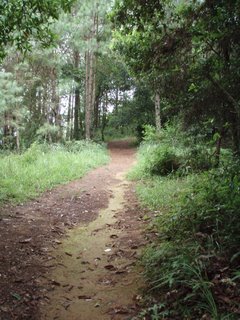
On that same hike, I was amazed at how quickly we were in the jungle, away from any city noise. Jungle is the word to use, considering it is actually a loan word from the Hindi/Nepali Sanskritic languages to English. When the British were in India, all the locals called the forest "jungle," and they adopted it as a term to describe the thick sub-tropical mess of shrub and tree, filled with tigers and rhinos and other fierce beasts the British and Indian Raj's loved to tromp around the jungle to shoot in mass quantity. That day the only wildlife we saw were leeches, spiders, and birds.
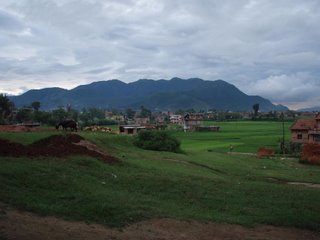
The village that I will complete my move to in about a week, once I get my visa back from the foreign ministry, a mobile phone, and a motorcylce. I've paid the first half down for the bike, and am going to have daily lessons in the evenings with ram for the rest of the week.
 Dorje Tsering the tibetan tailor, my homestay father in 2003-04 in Boudha, Kathmandu, Nepal, who remains one of my best friends in the eastside neighborhood. I have dinner with him and his wife and daughter at least once a week, and often come by his modest shop to drink tea and chat. We usually talk about politics or local news. He is not a particularly educated man, and his serious thoughtful demeanor in this photo belies his goofy nature.
Dorje Tsering the tibetan tailor, my homestay father in 2003-04 in Boudha, Kathmandu, Nepal, who remains one of my best friends in the eastside neighborhood. I have dinner with him and his wife and daughter at least once a week, and often come by his modest shop to drink tea and chat. We usually talk about politics or local news. He is not a particularly educated man, and his serious thoughtful demeanor in this photo belies his goofy nature. Ram and Santoshi Ballav in their dvd shop in Boudha, Kathmandu. I have been staying with them on and off this summer and last summer, as they manage the flats above their shop. It is a good deal for me since I can pay by the day for a room that shares a kitchen and bathroom with other students and travelers, so it has the feel of an apartment but the convenience of a guest house. I also have a near unlimited access to their dvd's, so i've watched some good ones lately, namely "spring, summer, fall, winter, and spring," "everything is illuminated," and "travellers and magicians," which is Dzongtsar Khyentse Rinpoche's new Bhutanese film.
Ram and Santoshi Ballav in their dvd shop in Boudha, Kathmandu. I have been staying with them on and off this summer and last summer, as they manage the flats above their shop. It is a good deal for me since I can pay by the day for a room that shares a kitchen and bathroom with other students and travelers, so it has the feel of an apartment but the convenience of a guest house. I also have a near unlimited access to their dvd's, so i've watched some good ones lately, namely "spring, summer, fall, winter, and spring," "everything is illuminated," and "travellers and magicians," which is Dzongtsar Khyentse Rinpoche's new Bhutanese film. Looking southwest at sunset across the sacred Bagmati River in east Kathmandu towards the Kirateshwar hill, which is topped by an old sangeetashram, a community space for devotional musicians. Every purnima (full moon evening) they hold a free public concert showcasing local Hindustani classical artists, I've probably attended six in the last three years. It is my favorite venue in the world, as it oozes with authenticity and sacrality; the only problem are the monkeys swinging around overhead during the evening music, which borders on devotional service.
Looking southwest at sunset across the sacred Bagmati River in east Kathmandu towards the Kirateshwar hill, which is topped by an old sangeetashram, a community space for devotional musicians. Every purnima (full moon evening) they hold a free public concert showcasing local Hindustani classical artists, I've probably attended six in the last three years. It is my favorite venue in the world, as it oozes with authenticity and sacrality; the only problem are the monkeys swinging around overhead during the evening music, which borders on devotional service.  On August 7, 2006, the day before I left on a plane from Kathmandu to Delhi, India, to meet Neil Guidry and the Tulane Social Work Masters students to tour Himachal Pradesh, I hiked around in Nagarjun forest preserve in northwest Kathmandu with some friends. This is a view to the southeast of Kathmandu, on the hill in the center of the photo is Swayambu Stupa, an ancient Buddhist reliquary monument that looks out over the valley; said to have arisen spontaneously as a lotus out of the dried lake that is the Kathmandu Valley. Swayambhu literally means "self arisen" in Sanskrit.
On August 7, 2006, the day before I left on a plane from Kathmandu to Delhi, India, to meet Neil Guidry and the Tulane Social Work Masters students to tour Himachal Pradesh, I hiked around in Nagarjun forest preserve in northwest Kathmandu with some friends. This is a view to the southeast of Kathmandu, on the hill in the center of the photo is Swayambu Stupa, an ancient Buddhist reliquary monument that looks out over the valley; said to have arisen spontaneously as a lotus out of the dried lake that is the Kathmandu Valley. Swayambhu literally means "self arisen" in Sanskrit. On that same hike, I was amazed at how quickly we were in the jungle, away from any city noise. Jungle is the word to use, considering it is actually a loan word from the Hindi/Nepali Sanskritic languages to English. When the British were in India, all the locals called the forest "jungle," and they adopted it as a term to describe the thick sub-tropical mess of shrub and tree, filled with tigers and rhinos and other fierce beasts the British and Indian Raj's loved to tromp around the jungle to shoot in mass quantity. That day the only wildlife we saw were leeches, spiders, and birds.
On that same hike, I was amazed at how quickly we were in the jungle, away from any city noise. Jungle is the word to use, considering it is actually a loan word from the Hindi/Nepali Sanskritic languages to English. When the British were in India, all the locals called the forest "jungle," and they adopted it as a term to describe the thick sub-tropical mess of shrub and tree, filled with tigers and rhinos and other fierce beasts the British and Indian Raj's loved to tromp around the jungle to shoot in mass quantity. That day the only wildlife we saw were leeches, spiders, and birds. The village that I will complete my move to in about a week, once I get my visa back from the foreign ministry, a mobile phone, and a motorcylce. I've paid the first half down for the bike, and am going to have daily lessons in the evenings with ram for the rest of the week.
The village that I will complete my move to in about a week, once I get my visa back from the foreign ministry, a mobile phone, and a motorcylce. I've paid the first half down for the bike, and am going to have daily lessons in the evenings with ram for the rest of the week.
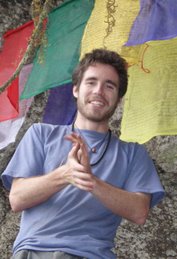

No comments:
Post a Comment